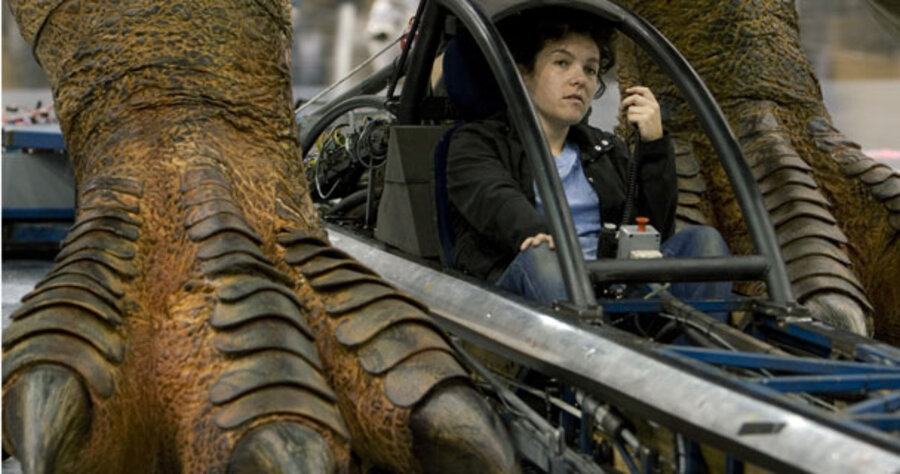'Walking with Dinosaurs' takes science to the sports arena
TACOMA, WASH. - The Tacoma Dome is no stranger to brawling monsters – it is a sports arena, after all. But this summer, it's the first stop for a different sort of leviathan, the Australian sensation "Walking with Dinosaurs: The Live Experience." The show made its US debut here in July.
Based on the Emmy Award-winning BBC TV series, seen by an estimated 700 million viewers, "Dinosaurs" is precisely what the title promises – 90 minutes of mammoth, life-size reptiles performing with lights, script, and music. Unlike many dino performers (think Barney), these Australian creations neither sing nor dance. They are scientifically accurate, not to mention technological and creative marvels – not bad for a passel of pachyderms from prehistoric times. And they are just the first wave of what their creators call "immersion edutainment."
"We've been hearing from everyone that high quality, live entertainment for kids is dying on the vine," says producer and entrepreneur Bruce McTaggart, "We want to change that."
He approached the BBC, whose "Walking with Dinosaurs" program mixed high-tech computer renderings of the creatures with in-depth scientific presentations. He felt they were the prefect place to start. "Who doesn't like dinosaurs?" says Mr. McTaggart. "They belong to everyone on earth and yet they're dynamic, we're still learning about them all the time."
But nobody, including the BBC, believed it was possible to translate the quality of the two-dimensional, computer creations to the stage. Enter a small army of some of the theater world's oldest and most traditional crafts – wigmakers, puppeteers, set and light designers, as well as directors, composers, and some very buff actors (the small costumes weigh over 50 pounds).
The result is a narrated tour through the many ages of the dinosaurs by a lone, onstage "archaeologist." In keeping with the educational thrust of the BBC TV series, the patter is full of the science and geology of the times – plate tectonics, continental drift as well as details about the 10 species represented, from the familiar T.Rex to the lesser known Liliensternus. All appear in the proper millennia and scientific order.
The biggest challenge was making the dinosaurs move properly. Herky-jerky, theme-park style animatronics would not do. "We wanted a fluid, believable movement onstage," says creature designer Sonny Tilders. They solved the problem with an elaborate combination of space-age puppetry, hydraulics, and age-old artistry. Vast metal skeletons draped with meticulously painted "skins" are powered by small electrically powered scooter cabs underneath each of the large creatures. Masked drivers maneuver the beasts.
Lead driver Angela Dufty, who pilots the T. Rex, says the hardest part is not running down her own young. The small animals are costumed actors. "It's hard to see everything on the stage and my baby darts around a lot," she says, plopping down into her custom seat, slung beneath the T.Rex tummy. "But on the other hand," she says with a wave at Brachiosaurus, "at least I don't have to navigate behind those huge front legs."
High above the stage, on the "Voodoo Lounge," a row of performers operate "voodoo rigs," small electronic rigs that duplicate the joints and moveable parts such as the eyelids and jaws of the large "puppets" in the arena. Each of the giant creatures has two voodoo operators who control the creature's smaller motions. The roaring jaws and neck, the giant, flipping tail, the blinking eye are all controlled from up top in one giant, long distance pas-de-dinosaur ballet.
The production is directed by Scott Faris, a veteran of the massive EFX stage show in Las Vegas who also has Broadway experience. It's a mistake to think of this as a sort of glorified kiddie show, says Mr. Faris. "All the sound and light and set design people are from theater," he says. "We felt it had it had to be like any dramatic piece where the audience gets involved with action [that] rises into a climax and then a resolution. We tried to apply those principles within a two-act narrative."
Hence, the mother T.Rex must protect her offspring from attack and the soaring Ornithocheirus must fight off the raptors who know that the winged creatures must eventually land.
Everyone on the production shares a certain air of pioneering excitement. After a sold-out 10-week run earlier this year in Australia, the team had a chance to regroup and tweak the show before it moved stateside. "We figured out how to make the wings flap more believably," says technician Chris Younger. "We got a more powerful winch to pull them up so now they don't jerk."
Out in the audience, during one of the final run-throughs before opening, the emotions are high, even without an audience.
"Some of these improvements are just coming together now," says Faris, looking down from the Voodoo Lounge. The projections on the large screen behind the action and some of the original music are still being tweaked. But to a first-time observer, there's such a terrifying, visceral impact of sitting beneath the swooping tail of a T.Rex replica come to vivid life with a scream of maternal protection, that it's hard to imagine what could be improved.
This, of course, is the point. "Kids today wouldn't sit through a boring science lecture," says science journalist Tim Haines, who supervised the original BBC show. "This is really pure science in disguise, but dressed up for today's audiences." He believes the show adheres to the rigorous science of the TV series.
"Walking with Dinosaurs" was a sellout in Tacoma – the Dome's biggest event ever. As it begins its North American conquest, the original design team is heading back to Australia one by one to work on "the second build." That would be for a production tentatively scheduled for a European tour. An Asian tour is not far behind.
Dinosaurs once ruled this planet. Seems they just might do it again.





